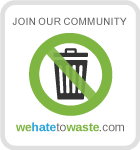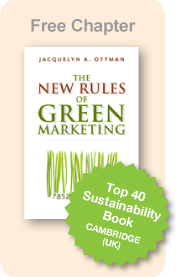Jacquie Ottman's
Green Marketing Blog
Certification and Eco-Labeling: What New Players Can Learn from Energy Star
July 10, 2009 by assistant
What can up-and-coming eco-labels learn from the success and longevity of the Energy Star program in order to become more familiar with consumers? By Rosemary De Vos
Do eco-labels and certifications drive purchasing? Can they be developed and marketed credibly? Given all the noise in eco-labelling right now, is there one bit of room for a new player?
At the Sustainable Brands 09 conference in Monterey in early June, there was hard evidence to suggest that certification and labeling are in fact influential in getting consumers to opt for one brand of consumer products, or consumer durables and services over another. And, with the opportunity to emulate the successful approach of Energy Star, there is more room for others who take the initiative and who get it right.
Jill Vohr, Marketing Manager for the US EPA demonstrated that their increasingly well-recognized Energy Star label for energy efficient products, is one of the trusted pioneers for its environmental claims and testing criteria. With its popularity as a recognised label, evidence is coming to light suggesting that Energy Star may offer a ‘halo effect’ for consumer electronics brands sporting its certification and this impression is now confirmed from recent, independent consumer surveys.
For example, poll results presented at the conference from BBMG’s 2009 Conscious Consumer Report on Renewable Energy indicated that 89% of respondents who, given the purchasing choice favored renewable energy sources, were familiar with Energy Star. This score was second only to the same sample’s recognition of the term, “recyclable”, on product packaging.
When questioned on which seals or labels they “always” looked for when shopping for various products or services, 48% of these respondents mentioned Energy Star then Recyclable (chasing arrows label), USDA Organic and Smart Spot (pre-cursor to Smart Choice), the top three runners up.
For clarity, an item carrying the Recyclable chasing arrows label must be able to be collected, separated or otherwise recovered from the solid waste stream for reuse, or in the manufacture or assembly of another package or product, through an established recycling program; USDA Organic presents the consumer with approved sources of egg, meat and poultry products ; and Smart Spot, the label developed by PepsiCo (which precedes the launch of Smart Choice, mid-2009) bids to educate consumers on the level of fats, salts and sugars and overall calorie content of a range of foods and beverages carrying the label.
In a separate BBMG 2009 Conscious Consumer Report on Health, seeking to discover what drives health conscious consumers, survey results for familiarity with certification and labeling were even more impressive. It was a close call between the first and second places with Recyclable (chasing arrows label) claiming 87% familiarity and Energy Star achieving 86% recognition. USDA Organic and Smart Spot (pre-cursor to Smart Choice) achieved 69% and 51% respectively, attaining third and fourth places. Interestingly, despite this segment prioritizing health benefits, the respondents were only slightly more familiar with food labels than average consumers.
When questioned on which seals or labels they “always” looked for when shopping for various products or services, 42% of these Health respondents mentioned Energy Star, 30% mentioned Recyclable (chasing arrows label), then USDA Organic and Smart Spot (pre-cursor to Smart Choice) achieved 14% and 13% respectively.
With such important results, what is preventing the development of similar certification and labelling for other products and services? UL Environment Inc, a newly launched version of the 115-year old global certifier, a supporter of the Energy Star approach to formalize test criteria and validate claims, advocates further research to find more benchmarks, appropriate testing criteria and a push for greater consumer education and awareness.
In his own Sustainable Brands 09 presentation, Chris Nelson, Director of Global Commercial Development, UL Environment, summed up the threat to building such a program in the absence of official standards and regulations, as the tug of war between trust and credibility versus manufacturers’ marketing claims.
But Chris Nelson remained positive about future opportunities to create new publicly-recognized labels given such prominent market examples where the manufacturing lifecycle and materials flow are reviewed holistically, where stakeholder engagement in the process creates transparency and, finally, where association between brands adds value.
The Energy Star label shows off these benefits to their best advantage since their labelling process unites consumer and stakeholder interests in a common objective. Product designers, manufacturers, retailers and consumers all contribute to the efficacy of Energy Star’s eco-labelling claims and, with appropriate adaptation in different circumstances, there is no reason to suggest that these steps to success could not be emulated by other players in other categories.
Admittedly, the level of recognition Energy Star enjoys does offer insight into but one dimension of the enormous task of educating consumers universally. But scaling up a good idea has to start somewhere.
Uniting consumer protection groups, satisfying stakeholder interests, building lasting strategic relationships between manufacturers, retailers and consumers and creating growth, combine to communicate a very powerful message. With the potential to monetise the impact of certification and labelling there appear to be more reasons than not to help push forward the case for creating new, recognised benchmarks for consumer goods and services.
Energy Star has clearly stolen a march on the electronic goods market relative to energy efficiency, by taking an innovative approach towards customer awareness and education, but this sets an exciting precedent for the benefit of all industry sectors. Organisations questioning how best to convey their own sustainability messages now have a useful guide and reference point from which to build their own roadmap towards harnessing the power of claims verification and labelling.
For more information please see: www.ftc.gov; www.energystar.gov; www.bbmg.com; www.ulenvironment.com; www.greenmarketing.com; www.sustainablelifemedia.com.
Rosemary De Vos of Devos Consulting Ltd is an associate of J. Ottman Consulting. She can be reached directly at
.(JavaScript must be enabled to view this email address)
Click here to join our mailing list



 ShareThis
ShareThis

